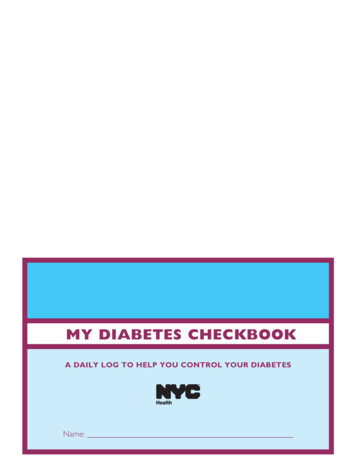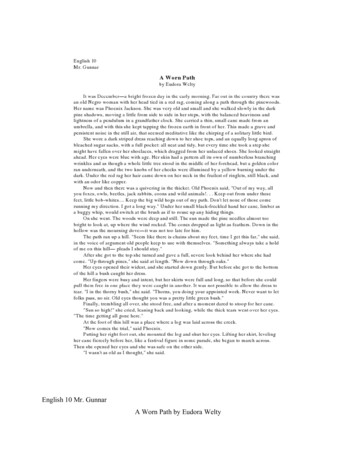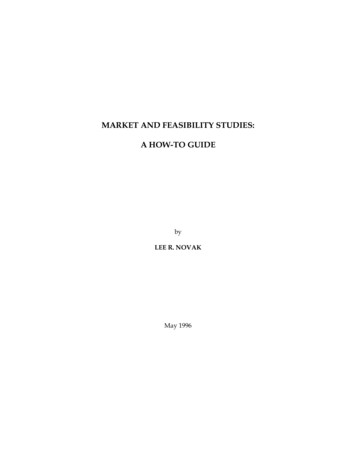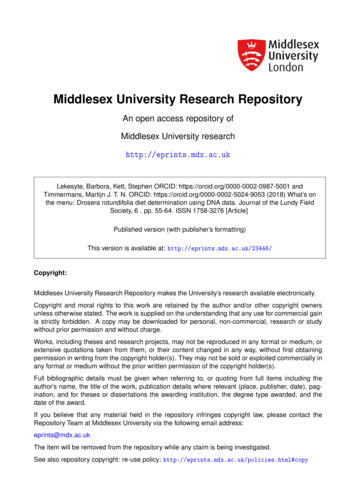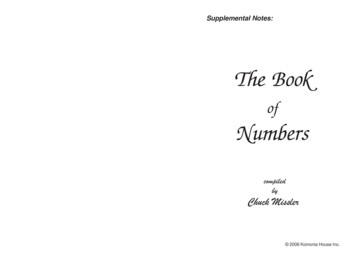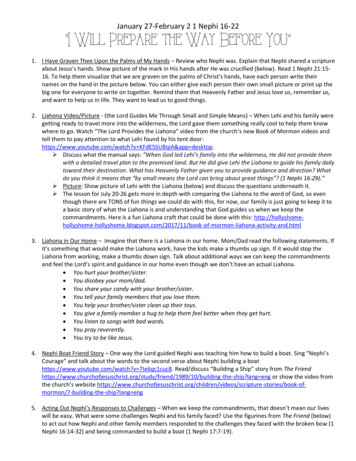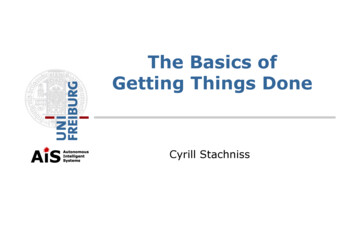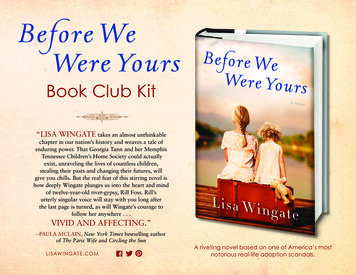
Transcription
Before We Were YoursA NOTEFROMClubBookLISA WINGATEKit“LISA WINGATE takes an almost unthinkablechapter in our nation’s history and weaves a tale ofenduring power. That Georgia Tann and her MemphisTennessee Children’s Home Society could actuallyexist, unraveling the lives of countless children,stealing their pasts and changing their futures, willgive you chills. But the real feat of this stirring novel ishow deeply Wingate plunges us into the heart and mindof twelve-year-old river-gypsy, Rill Foss. Rill’sutterly singular voice will stay with you long afterthe last page is turned, as will Wingate’s courage tofollow her anywhere . . .VIVID AND AFFECTING.”–PAULA MCLAIN, New York Times bestselling authorof The Paris Wife and Circling the SunL I SAWI N GAT E .COMA riveting novel based on one of America’s mostnotorious real-life adoption scandals.1
Before We Were YoursA N OTE FROM LI SA WI NGATEThe Foss children and the Arcadia were formed from the dustof imagination and the muddy waters of the Mississippi River.Though Rill and her siblings exist only in these pages, their experiences mirror those reported by children who were taken from theirfamilies from the 1920s through 1950.The true story of Georgia Tann and the Memphis branch of the Tennessee Children’s Home Society is a bizarre and sad paradox. There is littledoubt that the organization rescued many children from deplorable, dangerous circumstances, or simply accepted children who were unwantedand placed them in loving homes. There is also little doubt that countlesschildren were taken from loving parents without cause or due process andnever seen again by their desperately grieving biological families. Survivoraccounts bear out that empty-armed birth mothers pined for their missingchildren for decades and that many of those children were placed in holding facilities where they were neglected, molested, abused, and treated asobjects.Single mothers, indigent parents, women in mental wards, and thoseseeking help through welfare services and maternity clinics were particular targets. Birth mothers were duped into signing paperwork while underpostpartum sedation, were told that turning over temporary custody wasnecessary to secure medical treatment for their children, or were often simply informed that their babies had died. Children who lived through stintsin the home’s custody––those who were old enough to have memories oftheir prior lives––reported having been whisked from front porches, fromroadsides while walking to school, and, yes, from houseboats on the river.Essentially, if you were poor and you lived, stayed, or stopped over in theproximity of Memphis, your children were at risk.Blonds like the Foss siblings were particularly popular in Georgia Tann’ssystem and were often targeted by “spotters” who worked in medicalfacilities and public aid clinics. Average residents of the city, while unaware of her methods, were not unaware of her work. For years, citizenswatched for newspaper advertisements bearing photos of adorable babiesand children, underscored by captions like “Yours For the Asking,” “Wanta Real, Live Christmas Present?” and “George Wants to Play Catch, ButHe Needs a Daddy.” Georgia Tann was heralded as the “Mother of Modern Adoption” and was even consulted by Eleanor Roosevelt on mattersof child welfare.To the general public, Tann was simply a matronly, well-meaning woman who devoted her life to rescuing children in need. Her celebration ofchildren adopted by wealthy, well-known families helped to popularize theidea of adoption in general and dispel the widespread belief that orphanedchildren were undesirable and inherently damaged. Georgia’s high-profilelist included political figures such as New York governor Herbert Lehmanand Hollywood celebrities such as Joan Crawford and June Allyson andher husband, Dick Powell. Former staff members of Tann’s orphanage inMemphis whispered of as many as seven babies at a time being spirited2
Before We Were YoursA N OTE FROM LI SA WI NGATEaway under cover of darkness for transportation to “foster homes” inCalifornia, New York, and other states. In reality, these children wereoften being shipped off to profitable out-of-state adoptions in which Tannpocketed the lion’s share of the exorbitant delivery fees. When interviewedabout her methods, Georgia unabashedly extolled the virtues of removingchildren from lowly parents who could not possibly raise them properlyand placing them with people of “high type.”From a modern perspective, it’s hard to imagine how Georgia Tann andher network managed to operate largely unchecked for decades or whereshe found workers willing to turn a blind eye to the inhumane treatmentof children in the organization’s group homes and in unlicensed boardingfacilities, like the one where Rill and her siblings land, yet it happened. Atone point, the U.S. Children’s Bureau sent an investigator to Memphis toprobe the city’s soaring infant mortality rate. In a four-month period in1945, a dysentery epidemic had caused the deaths of forty to fifty childrenunder the care of Georgia’s facility, despite the efforts of a doctor who volunteered medical services there. Georgia, however, insisted that only twochildren had been lost. Under pressure, the state legislature passed a lawmandating the licensing of every children’s boarding home in Tennessee.The newly passed legislation included a subsection providing an exemption for all boarding homes employed by Georgia Tann’s agency.As you close these pages, perhaps you’re wondering, How much of thisis story is true? That question is, in some ways, difficult to answer. If you’dlike to dig more deeply into the real-life history of baby farms, orphanages, changes in adoption, Georgia Tann, and the scandal surroundingthe Tennessee Children’s Home Society in Memphis, you’ll find excellentinformation in Pricing the Priceless Child: The Changing Social Value ofChildren by Viviana A. Zelizer (1985), Babies for Sale: The TennesseeChildren’s Home Adoption Scandal by Linda Tollett Austin (1993), Alonein the World: Orphans and Orphanages in America by Catherine Reef(2005), and The Baby Thief: The Untold Story of Georgia Tann, the BabySeller Who Corrupted Adoption by Barbara Bisantz Raymond (2007),which also contains interviews with several of Georgia Tann’s victims.For a view of the scandal as it broke, see the original Report to GovernorGordon Browning on Shelby County Branch, Tennessee Children’s HomeSociety (1951), which is available through the public library system.There are also many newspaper and magazine articles available about thescandal as it happened and about the reunions of birth families in lateryears, as well as coverage in episodes of 60 Minutes, Unsolved Mysteries,and Investigation Discovery’s Deadly Women. All of these sources wereinvaluable to me as research materials.While Mrs. Murphy and her home in the story are fictional, Rill’s experiences there were inspired by those reported by survivors. There werealso many who, due to abuse, neglect, illness, or inadequate medical attention, did not live to tell their stories. They are the silent victims of anunregulated system fueled by greed and financial opportunity.3
Before We Were YoursA N OTE FROM LI SA WI NGATEEstimates as to the number of children who may have simply vanishedunder Georgia Tann’s management range as high as five hundred. Thousands more disappeared into adoptions for profit in which names, birthdates, and birth records were altered to prevent biological families fromfinding their children.One would assume, given these awful statistics, that Georgia Tann’sreign would have eventually ended amid a firestorm of public revelations, police inquiries, and legal action. If Before We Were Yours wereentirely fictional, that’s how I would have written its end, with scenesof swift and certain justice. Sadly, this was not the case. Georgia’s manyyears in the adoption business did not draw to a close until 1950. At apress conference that September, Governor Gordon Browning skirted theheartbreaking human tragedy of it all and instead discussed the money––Miss Tann, he reported, had benefited illegally to the tune of 1 million(equivalent to roughly 10 million today) while employed by the Tennessee Children’s Home Society. Despite the revelation of her crimes, Tannwas, by then, beyond the reach of legal action. Within days of the pressconference, she succumbed to uterine cancer and died at home in her ownbed. A newspaper exposé ran opposite her obituary on the front pageof the local paper. Her children’s home was closed and an investigatorappointed, but he soon found himself stymied by powerful people withsecrets, reputations, and, in some cases, adoptions to preserve.While the closing of the home gave grieving birth families reason tohope, that hope was quickly snatched from them. Legislators and politicalpower brokers passed laws legalizing even the most questionable of heradoptions and sealing the records. Of the twenty-two wards remainingin Tann’s care at the time of her death, only two—who had already beenrejected by their adopted families—were returned to their birth parents.Thousands of birth families would never know what became of their children. The general public sentiment was that, having been given over frompoverty to privilege, the children were better off where they were, no matter the circumstances of their adoptions.While some adoptees, separated siblings, and birth families were able tofind one another through pieced-together memories, documents spiritedfrom courthouse files, and the assistance of private investigators, GeorgiaTann’s records would not finally be opened to her victims until 1995. Formany birth parents and adoptees, who grieved their losses throughouttheir lifetimes, that was simply too late. For others, it was the beginningof long-delayed family reunions and the opportunity to finally tell theirown stories.If there is one overarching lesson to be learned from the Foss childrenand from the true-life story of the Tennessee Children’s Home Society, itis that babies and children, no matter what corner of the world they hailfrom, are not commodities, or objects, or blank slates, as Georgia Tannso often represented her wards; they are human beings with histories, andneeds, and hopes, and dreams of their own.4
Before We Were YoursH I STO RI CAL I M AGE SSiblings offered in a “Christmas Baby”ad. The Christmas Baby giveaway wasa popular fixture in Memphis papers foryears.The Poplar Street mansion that housed the headquarters of The Tennessee Children’s Home Society,Memphis Branch.(All images credited to Preservation and Special Collections Department, University Libraries, University of Memphis)Georgia Tann posing with Baby Lucy, who isbeing cleaned up for adoption.5
Before We Were YoursH I STO RI CAL I M AGE SGeorgia Tann posing in the reception parlor ofthe Poplar Street Mansion that served as her mainorphanage and the headquarters for her childbrokering business.A TCHS ward offered as “Yours for the Asking!”in the Memphis paper. Such ads became socommonplace that some citizens of Memphislooked forward to the photos of the cuteorphans with catchy titles and stories.(All images credited to Preservation and Special Collections Department, University Libraries, University of Memphis)A young Tennessee Children’sHome Society ward advertisedin the newspaper.6
Before We Were YoursF OO D I D E A S F O R YOU R BOO K CLU B E VE N TSOUTHERN FRIED CATFISHDIRECTIONSServes: 41. Heat a fryer or a deep pot halfwayfilled with oil to 350 F. Eight 5- to 6-ounce catfish fillets,skin removed2. Sprinkle both sides of each catfish withsalt and crab boil seasoning. Salt3. In a separate bowl, combine the flourand the cornmeal. Crab boil seasoning 4 cups all-purpose flour 1 cup cornmeal Oil, for frying4. Dredge the catfish in the flour mixtureand place in fryer.5. Deep fry for approximately 7 to 8minutes until done.6. Drain on paper towelsCredit: FoodNetwork.com“A POWERFUL TALE OF FAMILY, OF SISTERS, OF SECRETS KEPT AND SECRETS SHARED.I absolutely loved this book. I’m still basking in the afterglow, in shock at the true-crime elements,in awe at the journey of these characters who seem to have immortal souls.”—JAMIE FORD, New York Times bestselling author of Hotel on the Corner of Bitter and Sweet and Songs of Willow Frost7
Before We Were YoursF OO D I D E A S F O R YOU R BOO K CLU B E VE N TBUTTERMILK BISCUITSServes: makes 10 biscuits 2 cups unbleached all-purpose flour, plus moreor dusting the board (if you can get White Lilyflour, your biscuits will be even better) ¼ teaspoon baking soda 1 tablespoon baking powder(use one without aluminum) 1 teaspoon kosher salt or 1 teaspoon salt 6 tablespoons unsalted butter, very cold 1 cup buttermilk (approximately)DIRECTIONS1. Preheat your oven to 450 F.2. Combine the dry ingredients in a bowl,or in the bowl of a food processor.3. Cut the butter into chunks and cut intothe flour until it resembles coarse meal.4. If using a food processor, just pulsea few times until this consistency isachieved.5. Add the buttermilk and mix JUST untilcombined.6. If it appears on the dry side, add a bitmore buttermilk. It should be very wet.7. Turn the dough out onto a flouredboard.10. You can gently knead the scrapstogether and make a few more, butthey will not be anywhere near as goodas the first ones.11. Place the biscuits on a cookie sheet—ifyou like soft sides, put them touchingeach other.12. If you like “crusty” sides, put themabout 1 inch apart- these will not riseas high as the biscuits put closetogether.13. Bake for about 10-12 minutes—thebiscuits will be a beautiful light goldenbrown on top and bottom.Credit: Food.com8. Gently, gently PAT (do NOT roll witha rolling pin) the dough out until it’sabout ½ inch thick. Fold the doughabout 5 times, gently press the doughdown to a 1 inch thick.9. Use a round cutter to cut into rounds.8
Before We Were YoursF OO D I D E A S F O R YOU R BOO K CLU B E VE N TOLD TIME BUTTERMILK PIEDIRECTIONSServes: one pie serves 8 pieces1. Soften butter, add sugar, creamtogether well. 9-inch unbaked pie shell2. Add flour and eggs, beat well. Stirin buttermilk, vanilla, and nutmeg. ½ cup butter 2 cups sugar 2 rounded Tbsp flour 4 eggs, beaten 1 cup buttermilk 1 teaspoon vanilla Dash nutmeg (optional)3. Pour into unbaked pie shell.4. Bake at 350 F for 45 to 50 minutes.5. Cool completely before serving.6. This pie is also wonderful with ahandful of chocolate chips, a handfulof chopped nuts, and a handful ofcoconut added to the pie shell beforeyou pour the filling in.“AN UNFORGETTABLE READ. This captivating novel will quite likely break your heart but because it’sLisa Wingate at the helm, you will not be left broken. She is a master storyteller and never fails to get to the heart of whatmakes us hold onto hope.” —SUSAN MEISSNER, author of Secrets of a Charmed Life9
Before We Were YoursF OO D I D E A S F O R YOU R BOO K CLU B E VE N TDIRECTIONS1. In a large glass measuring cup,place the tea bags and add thebaking soda.2. Pour the boiling water overthetea bags.3. Cover and steep for 15minutes.4. Take out the tea bags and donot squeeze them.SOUTHERN STYLESWEET ICED TEAServes: 12-15 6 regular tea bags 1 /8 teaspoon baking soda 2 cups boiling water 1 ½ -2 cups sugar 6 cups cold water5. Pour the tea mixture into a2-quart pitcher; add the sugar.6. Stir until the sugar is dissolved.7. Add in the cold water.8. Let cool; chill in the refrigerator and serve over ice.Credit: Food.comOLD FASHIONEDHOMEMADE FRESHLEMONADEDIRECTIONSServes: 62. Boil for 3 minutes, stirringregularly and heating untilmixture becomes clear andslightly thickened. ½ cup of boiling water 1 ½ cups of granulated sugar 1 ½ cups of freshly squeezedlemon juice (about 8 lemons) Zest of one lemon 5 cups of cold water Additional sliced lemon forgarnish (optional)1. Make a simple syrup bybringing ½ cup of water andthe sugar to a boil.3. Set mixture aside to cool.4. Zest one of the lemons; setaside.5. Squeeze the juice from about 8lemons or until you have 1 ½cups of lemon juice.6. Add the juice to a 2-quartpitcher along with the zest andcold water.7. Whisk in the cooled simplesyrup and refrigerate overnightor for at least 8 hours.8. Serve in tall glasses over ice andgarnish with lemon slices, ifdesired.Credit: DeepSouthDish.com10
Before We Were YoursQ&A WITH LISA WINGATEBefore We Were Yours is based on a shocking piece of history. How didyou come up with the idea?For me, every piece of fiction begins with a spark. From there, the storytravels on the winds of research and imagination. Before We Were Yourshad the most unexpected kind of beginning.I was up in the wee hours one winter night working and had the TV playing in the background. A rerun of the Investigation Discovery: DangerousWomen cycled through at about two in the morning. I looked up and sawimages of an old mansion. The front room was filled with bassinettes andbabies. There were crying babies, laughing babies, babies who were redcheeked and sweaty-faced and sickly looking. I tuned in and immediatelybecame fascinated by the bizarre, tragic, and startling history of GeorgiaTann and her Memphis branch of the Tennessee Children’s Home Society.One of the most shocking things about the story was how recent it was.Georgia Tann and her children’s home operated from the 1920s through1950. I couldn’t stop wondering about the children who had been victimized by Georgia’s system, who had been brokered in adoptions for profit.What became of them? Where are they now?After digging into the story, I was shocked by the scope of Georgia’s networkand the tragic consequences of her cruelty and greed. An estimated fivethousand babies and children passed through her hands. They were, quitesimply, offered as products. Prospective parents could choose hair color, eyecolor, age, gender, religious background, genetic predisposition for talentssuch as art and music. Tann ran frequent newspaper ads, offering childrenas “Christmas presents” and “Yours for the asking!”. It was just mindboggling and horrifying.How long have you been at work on this book? Did the book involvespecial research?About two years. Rill and her siblings in the novel and their shanty boat lifeon the Mississippi river began taking shape as I combed through accountsof birth parents who’d searched for their stolen children for decades andadoptees who’d searched for their birth families. Many of the children Tannoffered were like the Foss Children. They were not orphans or unwantedchildren, but had been stolen from front porches, back yards, and hospitalmaternity wards. For years, adoptees and birth families searched for oneanother. They fought for the right to see their records, but they were notsuccessful until 1996. For many birth parents and family members, who’dgrieved their lost little ones a lifetime, that was simply too late.My hope was to, in some way, tell their stories.11
Before We Were YoursQ&A WITH LISA WINGATEWhat do you think readers will most love about your new book?So much of what each of us experiences while reading a story doesn’t comefrom what’s on the pages but what’s inside us. For some readers, Before WeWere Yours will be a story of sisters, for others a story of family, for others astory of good versus evil, for others a story of personal triumph in the face ofoverwhelming obstacles.I can tell you what I personally love most about Before We Were Yours.For me, it is a story of human connections, of the power, the importance,the necessity of those connections. In a world that grows more technology-interactive and less human-interactive by the day, it’s easy to lose sightof what gives life its sweetest flavor. A chat with an old friend. A sunsetwatched from the porch together. An hour just lying in bed reading or talking. A walk side-by-side. A phone call. A hug. A note. In the end, both themodern-day and historical characters in Before We Were Yours are willingto risk everything else for one all-important thing—a place to be authenticand people to be authentic with. That’s what I love most about the book.I look forward to hearing what readers love most!Stories and books are meant to be shared. What do you think makes oneworth sharing?As human beings, we’re hardwired for sharing stories. We’ve been atit since before there were written alphabets, and words, and printingpresses, and yes, even e-readers with HD retina displays (imagine!). Ingenerations past, families, friends, and tribe members sat together aroundcooking fires and told stories that entertained, that brought laughter, thatencouraged bravery in battle, that reinforced moral lessons, and taughtthe young people who they were and where they came from. Guests whoshowed up for supper gave a tale and left with a tale to take along onthe journey. Stories, by their very nature, are somehow incomplete untilwe’ve added our thoughts to them and passed them on to someone new.What makes a story worth sharing? Why, the way in which it intersectswith your own story, with your life, your experiences, your thoughts andemotions, of course! Nothing in the world can drill down to the heart ofus the way stories do. When we share them and share our thoughts aboutthem, we’re connecting with one another at the deepest level.Have you always known you wanted to be a writer or was it an ideathat came along later in life?I’ve loved to write for as long as I can remember. My older brother wasa good writer, and when you’re the youngest in the family, you want todo what the older kids do. When he won a school award for his poem,“The Bee Went Under the Sea”, I was so impressed by his literary brilliance (and the blue ribbon) that I immediately went to my bedroom andcreated my first book, The Story of a Dog Named Frisky. Frisky’s tale was12
Before We Were YoursQ&A WITH LISA WINGATEcleverly illustrated and published on manila paper in multiple editionswhich sold very well in the grandparent market.Before We Were Yours tells a story within a story. Are dual timeframestories a challenge to write?Yes, dual timeframe stories present special challenges, but for me, there’ssomething especially profound about discovering a historical story that’stied to a story in modern day. I think the appeal of this kind of story,in which we’re watching as a current-day character discovers the life ofsomeone from the past, is that the story offers the thrill of discoveryin a unique way. The historical story becomes broader, richer, and in asense more real because we see how the threads of past lives reach intomodern day. I think most of us wonder about the rumors, tall tales andoft-repeated anecdotes in our families. How much is true? What reallyhappened? Who were the people who came before us? What secrets didthey have? We can’t help but imagine what might be hidden in our ownfamily histories and how it might have affected today’s generations. Stories in dual time frames are about discovering those connections andunearthing the long-buried secrets.As a writer, it’s an interesting dance, balancing dual time frames anda story within a story. It falls in the category of double-the-work anddouble-the-risk, but also double-the-fascination and double-the-reward.There’s twice as much research, but in doubling the research, you alsodiscover twice as many interesting historical facts, unanswered questions, and nearly-forgotten bits of history. Those fascinators weave newthreads into the story loom. For me, the biggest challenge ensuring thatboth stories are fully satisfying, and that the historical story serves apurpose in modern-day characters’ lives.13
Before We Were YoursMUSIC PLAYLIST INSPIRED BY THE NOVELBefore We Were Yours Playlist: "Summertime" by Billie Holiday "It Don’t Mean a Thing" by Duke Ellington "I Got Rhythm" by George Gershwin " Aura Lea (Love Me Tender)" by Elvis Presley(mentioned in the book) "Proud Mary" by Creedence Clearwater Revival "Whiskey River" by Willie Nelson "Lazy River" by Louise Armstrong " Ol’ Man River" by The Beach Boys or Paul Robesonor Frank Sinatra "Puttin’ On the Ritz" by Frank Sinatra "Isn’t It Romantic" by Ella Fitzgerald“LISA WINGATE’SHEART-RACING TALEof a family ripped apart bythe Tennessee Children’s HomeSociety scandal, rang so true Icouldn’t sleep until I knew theirfate. Days later, I’m still haunted bythe diabolical plot to steal and sellthe most vulnerable childrento high bidders, sanctioned byhigh-ranking officials who lookedthe other way.”—JULIE KIBLER, bestsellingauthor of Calling Me Home14
Before We Were YoursD I SCU S SI O N QU E ST I O N S1. Before We Were Yours alternates between the historical story of the FossChildren and the modern-day story of Avery Stafford. Did you have afavorite between these story lines? Which one and why?2. Many families have been touched in some way by adoption and fostercare. Is adoption or foster care in your family history? If so, how did thataffect your thoughts about the journey of the Foss children and aboutAvery’s excavation of her family history?3. When the sisters were originally reunited, they decided to keep their history to themselves rather than telling their families. Do you agree or disagree with this decision? What do you think the implications would havebeen if they had gone public? Do you think family secrets should remainsecret, particularly after the people who kept those secrets have passedaway? Or do family secrets belong to the next generation, as well? Haveyou ever discovered a secret in your family history? If so, what was it (ifyou care to share it, that is)?4. “There was a little girl who had a little curl . . .” is a touchstone betweenAvery and her Grandma Judy. Is there a song or saying that remindsyou of someone special in your childhood? Where does your mind travelwhen you hear it or repeat it?5. Avery laments that the busy schedule expected of a Stafford has prevented her from spending time on Edisto Island with her sisters or Elliot.“Who chooses the schedules we keep? We do, I guess,” she tells herselfbut excuses this with, “the good life demands a lot of maintenance.” Inour modern age are we too busy? Too preoccupied with accumulatingthings to actually enjoy what we have? Too dialed into media and socialmedia? What are your thoughts on this? What would you like to changeabout your own schedule? Anything? What might you gain if you did? 6. While Rill sees her life on the Arcadia through the idyllic eyes of childhood, May in her old age seems to acknowledge that she wouldn’t havetraded the life she lived for a different one. Do you think she wonderswhether Queenie and Briny’s unconventional existence on the Arcadiacould would have been sustainable as times changed or more childrenwere added to the family? Were Queenie and Briny responsible or careless in their choices?7. May says, “A woman’s past need not predict her future. She can danceto her own music if she chooses.” How has your past made you whoyou are? What do you want to leave behind? Anything? What is the true“music” of your own soul? Are you in step with it or out of step? Whathelps you hear your own music and find balance in your life?15
Before We Were YoursD I SCU S SI O N QU E ST I O N S8. When fear of being caught threatens to prevent her from escaping MissMurphy’s house, Rill tells herself, “I shush my mind because your mindcan ruin you if you let it.” Does your mind ever ruin you? In what way?On what issues? May comments, “We’re always trying to persuade ourselves of things.” Are women particularly guilty of this? What do we tellourselves that we shouldn’t?9. Child trafficking, abuse, and economic disadvantage still imperil the livesand futures of children today. What can we as ordinary citizens do toprevent children from being robbed of safe, happy childhoods? What cansociety do to prevent people like Georgia Tann from taking advantage ofthe most helpless and vulnerable among us?10. Did you search for more information about Georgia Tann and theTennessee Children’s Home Society after reading Before We WereYours? What did you learn? Based on what you learned, what do youthink motivated Georgia Tann? Why were so many people willing to becomplicit in her schemes when they knew children were suffering? WasGeorgia’s network a creature of the political corruption and societalattitudes of its time or could something like this happen today?11. Avery feels the pressure of being in a high-profile political family. Doyou think famous families are held to a higher standard than others?Should they be? Has this changed in recent years or is it just harder tokeep secrets in today’s media-crazed world?12. How did Avery grow as a result of her discoveries about the family’spast? How did it change her view of herself and her family’s expectations for her? Did your family have expectations for you that you didn’tagree with? Who in Avery’s family might struggle most to accept herdecision to change her life plans?13. Do you think there will be a happily-ever-after ending for Avery andTrent? In your view, what might that look like?14. How would you describe Rill as she struggles through the abduction,the orphanage, and her decision to return to her adoptive family? Didyou admire her? What changes did you see in her as a result of the experience? How is she different when she gets to the Sevier’s house?16
Before We Were YoursD I SCU S SI O N QU E ST I O N S15. Avery struggles to come to terms with Grandma Judy’s dementia. Herfamily wrestles with difficult choices about Grandma Judy’s care. Hasmemory loss and elder care affected your family? In what way? Whatissues did it cause and how did you deal with them? Have you imaginedwhat it would be like to be a victim of memory loss?16. The Seviers seem to have adopted the Foss girls with good intentions.Do you think th
Book Club Kit "LISA WINGATE takes an almost unthinkable chapter in our nation's history and weaves a tale of enduring power. That Georgia Tann and her Memphis . The Untold Story of Georgia Tann, the Baby Seller Who Corrupted Adoption by Barbara Bisantz Raymond (2007), which also contains interviews with several of Georgia Tann's victims.
